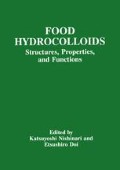Abstract
We examined the formation of curdlan gels by differential scanning calorimetry and electron microscopy. When curdlan heated in water to various temperatures was cooled, an exo-thermic peak appeared at about 40 °C, with formation of hydrogen bonds involving water to give gel. When the cooled preparations were heated again, endo-thermic peaks reappeared at about 60°C and exo-thermic peaks also appeared at higher temperatures. However, no exo-thermic peaks were observed on cooling and then heating above 145 °C. Thus, the gel formation caused by heating to 60-120 °C and cooling is reversible, but that caused by heating to above 145 °C and cooling is irreversible as shown by the heat analysis. In neutralized gel and the gel formed by heating at 55 or 60 °C and cooling, microfibrils of endless length consisting of fibrils of about 100 nm length and 10-25 nm width appeared. In gels obtained by heating at 70, 80, and 100 °C and cooling, microfibrils with released fine stubs appeared. Gels cooled after heating at 120 and 145 °C contained spindle shaped microfibrils of about 100 nm length and 30 nm width. Preparations obtained by heating to 170 °C and cooling gave microfibrils like those formed by unheated preparations.
Access this chapter
Tax calculation will be finalised at checkout
Purchases are for personal use only
Preview
Unable to display preview. Download preview PDF.
References
T. Harada, “Trends in Glycosciences and Glycotcchnology”,4:309(1992).
T. Harada, M. Terasaki, and A. Harada, in “Industrials Gums”,3rd ed. by R. L. Whistler, Academic Press, Inc. p427 (1993).
T. Harada, Y. Kanzawa, K. Kanenaga, A. Koreeda, and A. Harada, Food Structures, 10:1(1991).
Y. Kanzawa, A. Koreeda, A. Harada, and T. Harada, Agric. Biol. Chem.., 53: 979(1989).
T. Takeda, N. Yasuoka, N. Kasai, and T. Harada, Poly. J., 10: 365(1978).
K. Okuyama, M. Otsubo, M. Ozawa, T. Harada, and N. Kasai, Carbohydr. Chem., 10: 645(1991).
A. Konno and T, Harada, Food Hydrocolloids, 5:427(1991).
T. Harada, A. Koreeda, S. Sato, and A. Harada, Electron. Micros. 28:147(1979).
Y. Kanzawa, T. Harada, A. Koreeda, A. Harada, and K. Okuyama, Carbohydr. Polym.10: 299(1989).
A. Konno, H. Kimura, T. Nakagawa, and T. Harada, Nogei Kagaku-Kaishi, 6:247(1978).
H. Saito, Y.Yoshioka, M. Yokoi, and J. Yamada, Biopolymers, 19: 1689(1991).
C. T. Chuah, A. Sarko, Y. Deslandes, and R. H. Marchessault, Macromolecules, 16:1375(1983).
W. S. Fulton and A. D. Atkins, ACS Symp. Ser. 141. i n “Fiber Diffraction Methods”,ed by A. D. French and K. H. Gamer, p386(1980).
I. Maeda, H. Saito, M. Masada, A. Misaki, and T. Harada, Agric. Biol. Chem., 31:1184(1967).
T. Kuge, N. Suetsugu, and K. Nishiyama, Scientific Reports Kyoto Prefectural University, Agriculture, 31:170(1979), in Japanese.
T. Kuge, N. Suetsugu and K. Nishiyama, Agric. Biol. Chem., 41: 1315(1979).
Y. Yoshioka, N. Uehara, and H. Saito, Chem. Pharm. Bull., 40: 1221(1992).
Author information
Authors and Affiliations
Editor information
Editors and Affiliations
Rights and permissions
Copyright information
© 1994 Springer Science+Business Media New York
About this chapter
Cite this chapter
Konno, A., Okuyama, K., Koreeda, A., Harada, A., Kanzawa, Y., Harada, T. (1994). Molecular Association and Dissociation In Formation of Curdlan Gels. In: Nishinari, K., Doi, E. (eds) Food Hydrocolloids. Springer, Boston, MA. https://doi.org/10.1007/978-1-4615-2486-1_13
Download citation
DOI: https://doi.org/10.1007/978-1-4615-2486-1_13
Publisher Name: Springer, Boston, MA
Print ISBN: 978-1-4613-6059-9
Online ISBN: 978-1-4615-2486-1
eBook Packages: Springer Book Archive

